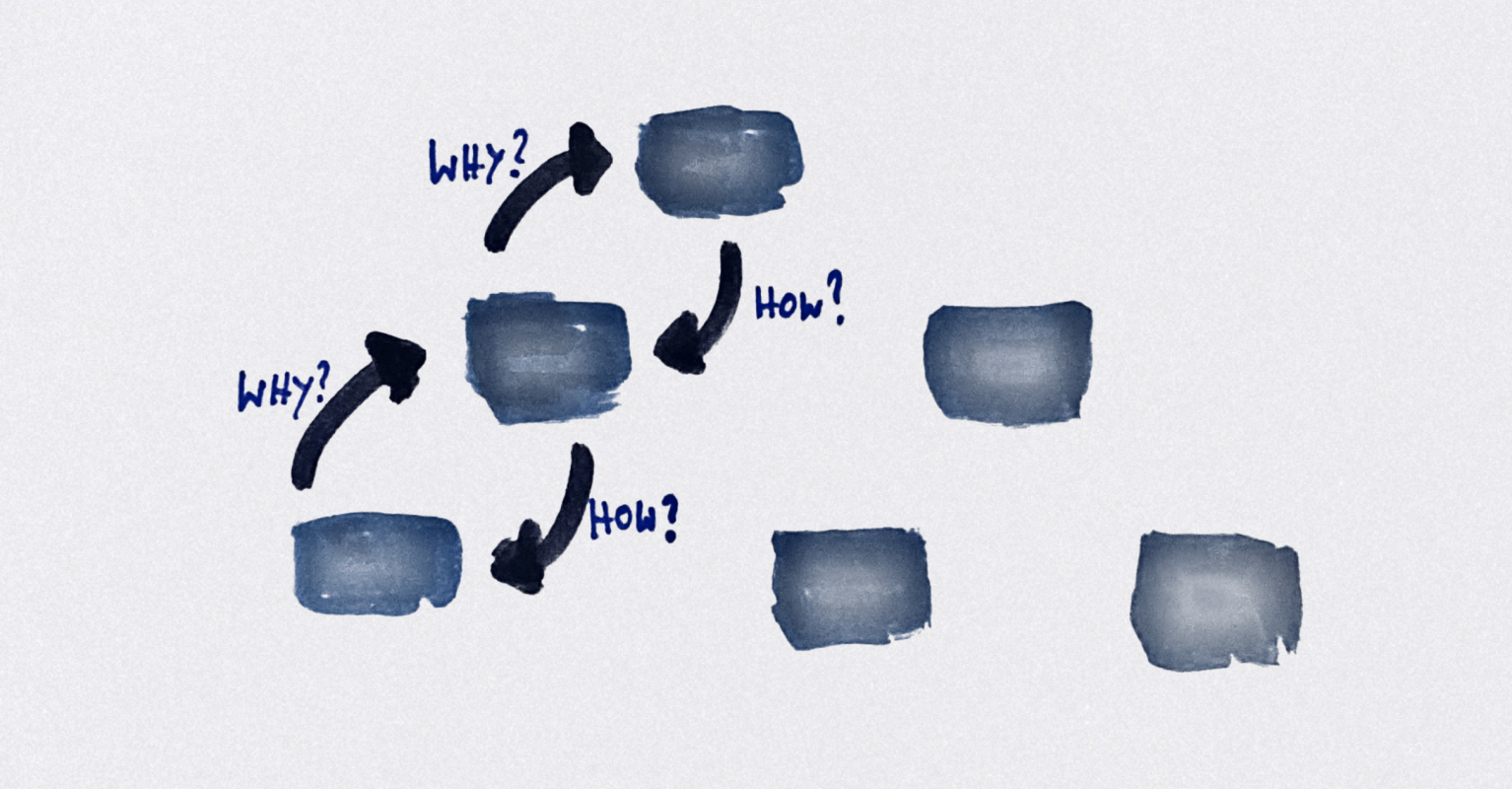What
Why/How Laddering is a way of reframing a problem or challenge by complementing its initial statement with more abstract and more concrete statements. Moving up the ladder expands the scope and helps see larger patterns and deeper needs, moving down helps find different concrete solutions.
Why
- Find connections between challenges or problem statements
- Create context for the original challenge or problem statement
- Understand wider challenges and deeper needs
- Generate alternative points of departure for ideation
How
- Number of participants: 3–6
- Time needed: 45–90 mins
- Material:
- Sticky notes in different colours
- Thick black markers
- Large board or wall space
Why/How Laddering helps you see larger patterns and overarching questions by moving up in abstraction, and find innovative solutions to your problem by moving down on alternative paths.
You can use it alone, but it’s more effective in a group of 3–6 people who bring different perspectives. Use a physical or virtual whiteboard and sticky notes and do the following steps:

- Write down your initial problem statement or challenge on a sticky note and put it at the centre of the whiteboard.
- Move up the ladder by asking “why?”. Do this repeatedly and write down the answers onto sticky notes as new, broader statements. Place each of them on the board above the initial statement, according to its level of abstraction. At a certain point, you’ll reach a very common, abstract need such as “health” or “happiness“. This is the top of the ladder. This process helps you frame the initial problem differently.
- Move down the ladder by asking “how?”. Start with different sticky notes and explore alternatives, writing down the answers as new, narrower statements. Place them on the board above, at the level of or below the initial statement, according to their level of abstraction. This helps you identify alternative ways to fulfil the needs needs behind the initial problem, and find points of departure for concrete solutions.
- Scan the emerging map of statements for patterns that can further inform your ideation, e.g. parallel ladders representing different causal mechanisms, different and potentially competing ultimate goals at the top, or differences in detail between different areas of the map, which point to differences in knowledge about these areas.
Tips
- Use the “How might we…?” format to express problem statements, e.g. “How might we avoid customer churn?”. This makes it easier for participants to think about solutions, and it provides a good interface to the “How Might We?” Questions method.
- Arrange and re-arrange the sticky notes in ways that make connections as clear as possible. Discuss which levels of abstraction specific notes belong to and whether there are notes missing between other notes.
- Be as comprehensive and precise as possible: If there is more than one answer to a “how?” or “why?” question, make sure you write them all down and follow the lines of thought opened up by them. Be broad in overall scope but narrow in what is captured in each individual note.
Where
- Can process output of: Persona, Customer Journey Map, Problem Statement, “How Might We?” Questions, Concept Mapping
- Can feed input to: Problem Statement, “How Might We?” Questions, Concept Mapping
Caveat
Why/How Laddering is at its core a bottom-up Causal Model of a problem space, i.e. a Complex System. Similar to Concept Mapping, it can suggest that a bottom-up mapping of such a system can generate a complete description of it. In reality, we will often overlook or severely misjudge elements of its Causal Structure.
As a consequence, the method should be used as a Heuristic Device and embedded in an iterative process in which we Launch safe-to-fail probes and adapt models continuously.
Provenance
Why/How Laddering, also known as Abstraction Laddering, was originally developed by Sidney J. Parnes at the International Center for Studies in Creativity at Buffalo State College in the 1950–60s as part of the so-called Creative Problem Solving process.
Parnes’s colleague Min Basadur further developed the method into what he called Challenge Mapping or “Why-what’s stopping” analysis since the mid-1970s, culminating in Basadur (1994) .
From there the method got adopted in Design Thinking, mostly under the title of Why/How or How/Why Laddering.
References
- Basadur (1994): “A New Methodology for Formulating Ill-structured Problems”